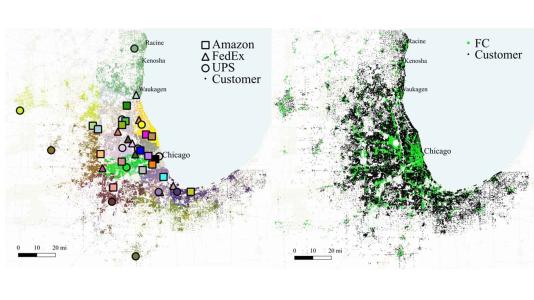首都圏の平均風速は、エネルギー使用量の推定に欠かせない Average wind speed in a metro area is critical to estimating energy usage
2023-03-01 アルゴンヌ国立研究所(ANL)

The truck routing model finds optimal routes to deliver goods as well as optimizing the number of trucks to be used. The images show customer locations and FCs for both the drone delivery and the truck delivery cases. The truck delivery map depicts customers served by a depot. (Image by Argonne National Laboratory.)
この研究によると、風速が10マイル/時を超えた場合、ドローンの省エネ効果はなくなり、風速が20マイル/時を超えるとディーゼルトラックと同等のエネルギーを必要とすることが分かった。
この研究は、ドローン配送が省エネになるかどうかを比較するため、直接的なドローン配送のエネルギー消費量を地域エネルギー消費量や施設コストと比較したものである。
研究者たちは、気象条件、技術進歩、需要の不確実性などを考慮しながら、配送業界にドローン配送の可能性を示唆している。
<関連情報>
- https://www.anl.gov/article/argonne-drops-data-on-the-question-of-efficient-drone-use-for-ecommerce-deliveries
- https://journals.sagepub.com/doi/abs/10.1177/03611981221145137?journalCode=trra
ドローンによる直接配達とトラックによる配達の地域エネルギー消費量の比較 Comparing Regional Energy Consumption for Direct Drone and Truck Deliveries
Taner Cokyasar,Monique Stinson,Olcay Sahin,Nirmit Prabhakar,Dominik Karbowski
Transportation Research Record Journal Published:January 12, 2023
DOI:https://doi.org/10.1177/03611981221145137
Abstract
Drone delivery, once thought of as fictitious, is becoming a reality with the efforts of both forward-looking enterprises and supportive government policies. This emerging mode of e-commerce delivery raises many concerns. One important concern is the energy efficiency of direct delivery drones compared with conventional delivery trucks at a regional systems level. In this study, we develop and apply methods to quantify the regional energy impacts of drone delivery, then we assess these impacts and compare them with the impacts of truck delivery. To study this problem, we develop an optimization model that determines an optimal set of fulfillment centers (FCs) with variable service capacities that allow drones to make direct e-commerce deliveries. We adopt two drone delivery energy estimation models from the literature and use them as inputs to demonstrate the potential range of energy needs. We also develop another optimization model to account for the energy consumption of diesel trucks (DTs) and battery electric vehicles (BEVs). We test the models using validated simulation data for the Chicago metropolitan area in the U.S. to quantify the energy implications of these three delivery modes. For drone delivery, we further extend our analyses by considering the impact of wind speed and flight patterns. Our results show that direct delivery drones require 15.8% more energy than BEVs on an average windy day, and they need 15% more energy than DTs on a very windy day. We provide essential parameter values for reproducibility and list relevant open problems.



